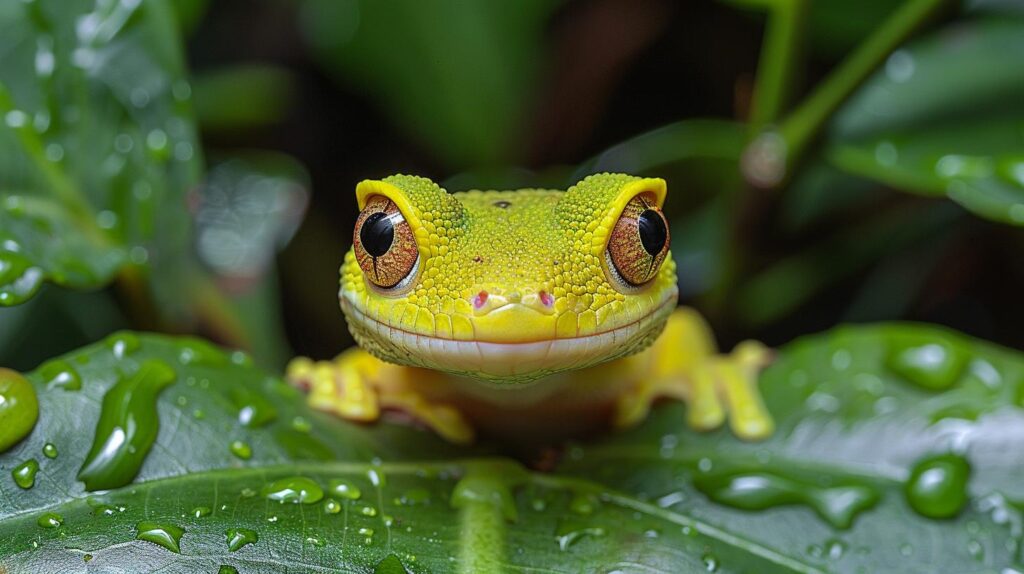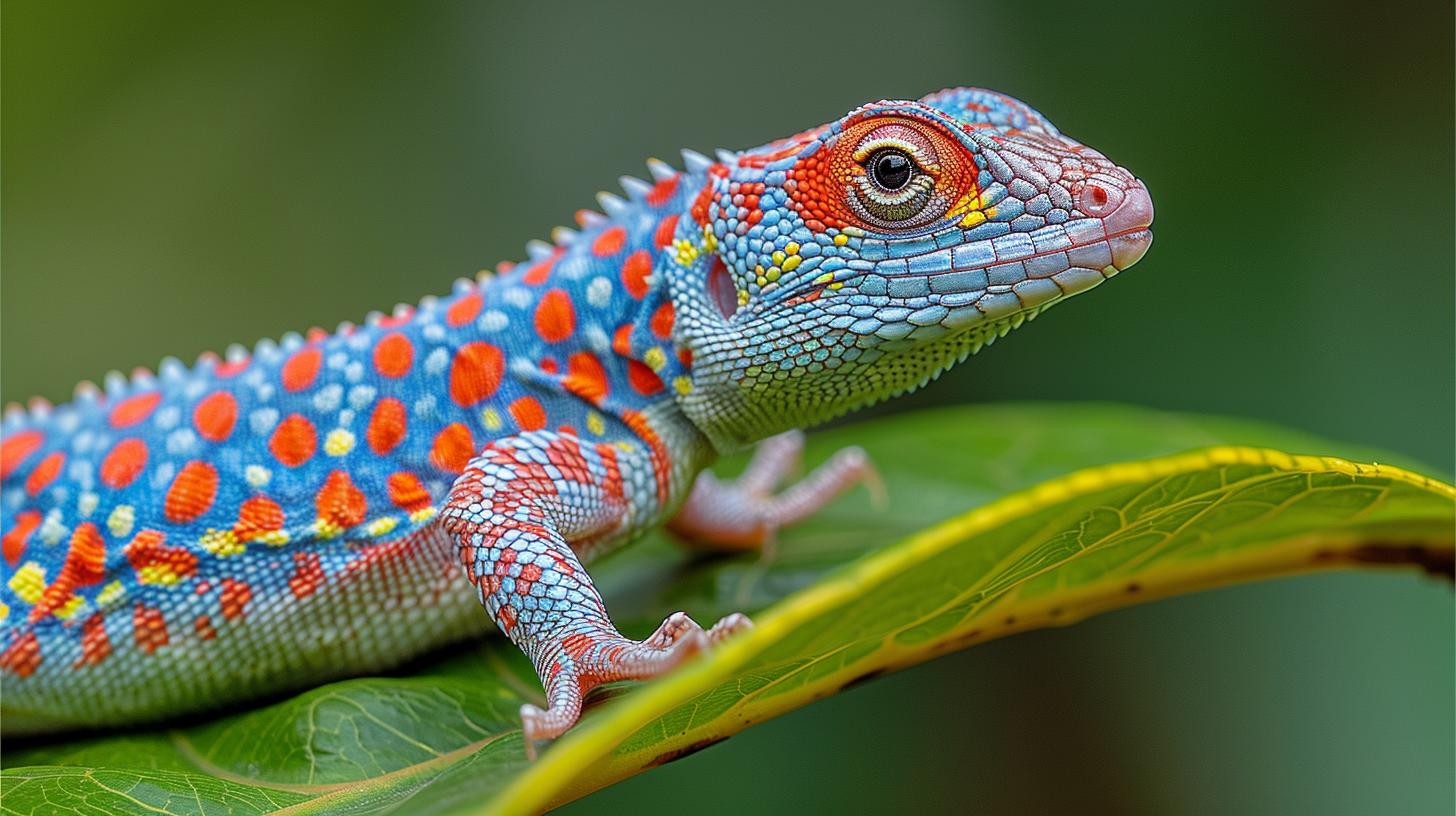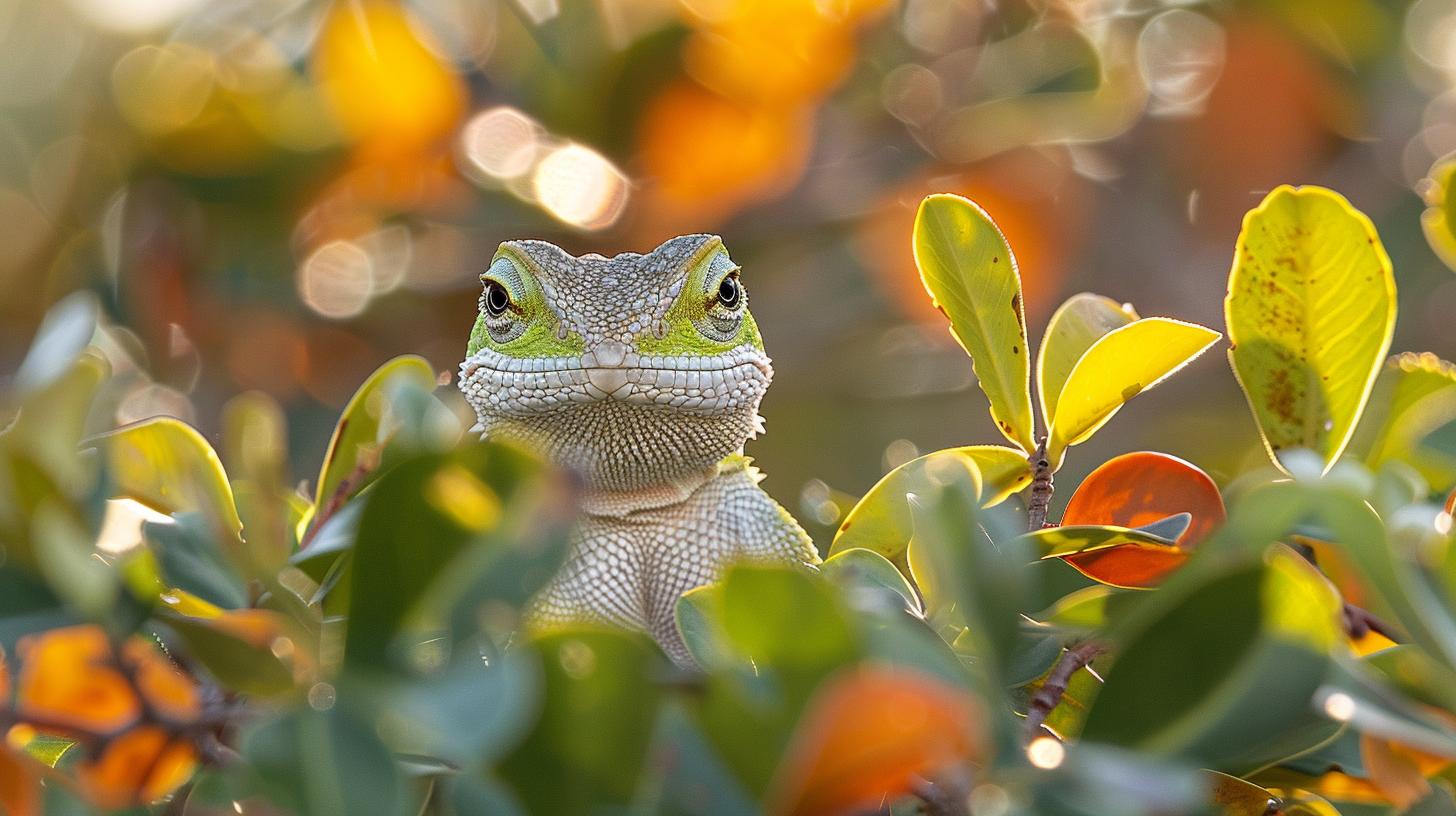3 Best Safe Plants for Reptile Habitats

Introduction to Reptile Habitats and the Importance of Natural Elements
Creating a naturalistic home for reptiles isn't just about aesthetics; it's integral to their health and happiness. This begins with the careful selection of safe reptile habitats plants, which play a pivotal role in replicating the environmental conditions these creatures would experience in the wild.
The correct foliage can transform an ordinary terrarium into a thriving ecosystem, where your reptiles can enjoy a piece of their native habitat right inside your home. By integrating living plants, not only do you enhance the enclosure's visual appeal, but you also provide a more stimulating and beneficial environment for the inhabitants.
Understanding what constitutes safe plants for reptile habitats is essential. These are plants that must be non-toxic, meaning they pose no chemical risk if ingested or touched by the reptiles. Additionally, they should be compatible with the climate of the habitat-tropical plants for humid enclosures and desert varieties for drier ones.
Avoiding plants with sharp edges or spines is crucial to prevent injury to your reptilian companions. This knowledge empowers pet owners to make informed decisions when decorating their pet's space, ensuring it's both beautiful and benign.
The impact of incorporating suitable plants into your pet's environment cannot be overstated. Beyond mere decoration, they contribute significantly to maintaining humidity levels appropriate for your pet's needs, creating hiding spots that offer security and stress relief, and facilitating natural behaviors such as climbing or basking among leaves.
Safe habitat plants help in mimicking natural ecosystems, which is vital for the physical and psychological well-being of captive reptiles. Thus, selecting the right greenery is not just about making their enclosures more visually appealing; it's about enriching their living spaces in ways that promote healthier, happier lives.
Understanding the Criteria for Safe Reptile Habitat Plants
Introducing greenery into a reptile's environment goes beyond mere decoration; it plays a crucial role in recreating a natural and comforting habitat where they can thrive. However, not all plants are suitable for these specialized habitats. Knowing what makes certain plants safe and beneficial for reptile enclosures is fundamental. This knowledge ensures that pet owners can make informed decisions, creating environments that mimic the reptile's natural ecosystem while avoiding potential hazards.
The selection of safe reptile habitats plants requires careful consideration of various criteria to ensure they contribute positively to the enclosure's ecosystem. These criteria include non-toxicity, suitability for the specific climate within the enclosure, and physical characteristics of the plants that pose no risk to the reptiles.
By understanding these essential aspects, reptile enthusiasts can provide their pets with not only a visually appealing space but also a functional one that supports their health and well-being.
Non-Toxicity: A Core Requirement
One of the primary considerations when selecting flora for a reptile habitat is ensuring that chosen plants are non-toxic. Reptiles might occasionally nibble on leaves or stems, making it paramount to choose plant species known for being harmless if ingested. Non-toxicity guarantees that accidental consumption won't lead to health issues like digestive problems or poisoning, safeguarding your pet's health.
Climatic Compatibility: Ensuring Environmental Balance
Besides non-toxicity, climatic compatibility plays a significant role in selecting suitable safe reptile habitats plants The temperature and humidity levels within the enclosure should align with the natural growing conditions of the plant. This ensures its survival and growth without requiring significant adjustments to your pet's environment. Plants well-suited to your habitat's climate help maintain balance, enhancing humidity regulation and air quality - key components in replicating natural ecosystems.
Avoidance of Physical Hazards
Finally, when choosing plants for your reptile's home, consider their physical structure. Avoid species with sharp edges or thorns that could potentially injure your pet. Preferably select plants with softer foliage which offer additional hiding spots and climbing opportunities without posing any risk of harm. This aspect underscores once again how integral thoughtful selection is when curating safe spaces that suit both aesthetic preferences and functional needs within reptile enclosures.
By adhering to these criteria-non-toxicity, climatic compatibility, and absence of physical hazards-reptile keepers can create optimum environments that promote their pets' health while adding vibrant life to their habitats through carefully selected vegetation.
The Vital Role of Proper Plant Selection
In the quest to cultivate a conducive environment for reptiles, the selection of appropriate plants plays an unprecedented role. This phase of designing safe reptile habitats revolves around choosing foliage that not only meets aesthetic desires but also supports the physiological and psychological needs of the inhabitants.
When executed correctly, incorporating specific varieties of flora can significantly enhance the quality of life for reptiles by replicating elements of their natural ecosystems. Hence, understanding which plants are safe and beneficial becomes paramount in this meticulous process.
The emphasis on proper plant selection transcends mere decoration; it delves into creating an interactive and stimulating environment for reptiles. By introducing suitable safe reptile habitats plants, caretakers can provide their cold-blooded charges with essential hiding spots and climbing structures, mimicking their natural behavior in the wild. This strategic choice goes beyond aesthetics, addressing fundamental aspects of reptile wellness including stress reduction, behavioral enrichment, and physical health maintenance.

Enhancing Habitat Humidity
Certain species require a carefully controlled humidity level within their enclosures for optimal health, making the choice of moisture-retentive plants critical. Plants such as ferns contribute naturally to maintaining desired humidity levels, thereby reducing the need for artificial humidifiers. The transpiration process allows these plants to release water vapor into the air, subtly increasing enclosure humidity in a way that complements the environmental needs of various reptiles.
Providing Natural Hiding Spots
A crucial aspect often overlooked in reptile habitat design is the provision of adequate hiding spaces to ensure animals feel secure and undisturbed. The strategic placement and selection of dense foliage or broad-leaved plants create naturalistic shelters where reptiles can retreat when stressed or seeking solitude. Not only does this promote natural behavior, but it also significantly contributes to their overall well-being by offering a sanctuary within their enclosures.
Contribution to Ecosystem Mimicry
Replicating a portion of the wild ecosystem indoors is no small feat; however, through careful plant selection bearing in mind compatibility with climate and toxicity parameters, one can approximate a native habitat that supports healthy reptile life. This includes not just survival but thriving mentally and physically through engagement with natural structures akin to those they would encounter in the wild. It reinforces how indispensable informed plant choices are-to construct environments that cater holistically to our scaled companions' requisites.
First Recommended Plant
The Spider Plant, scientifically known as *Chlorophytum comosum*, stands out as one of the top selections for creating safe reptile habitats with plants. Its popularity can be largely attributed to its non-toxic nature, making it a secure choice for a wide range of reptile species. Moreover, spider plants are renowned for their air-purifying qualities, which contribute to a healthier environment within the enclosure by removing pollutants.
Caring for spider plants is relatively straightforward, which suits both novice and experienced reptile keepers alike. They thrive in moderate to bright indirect light but can also adapt to less ideal conditions with ease. To ensure the plant benefits your reptile habitat fully:
- Keep the soil lightly moist but avoid overwatering.
- Place it in a spot where indirect sunlight is available.
- Regular trimming of brown or damaged leaf tips will keep the plant healthy and visually appealing.
Integrating spider plants into reptile enclosures not only enhances aesthetic appeal but also offers practical advantages. Their lush foliage provides excellent coverage and hiding spots that many reptiles seek for stress relief and privacy. Additionally, these plants play a role in maintaining stable humidity levels within the enclosure, an essential factor in replicating natural habitats effectively.
When considering safe reptile habitats plants, remember that balance is key. A variety of plant types encourages biodiversity and mimics natural ecosystems more closely, offering your reptiles a richer and more stimulating environment. In this regard, supplementing your habitat with spider plants alongside other recommended safe varieties contributes significantly to achieving this goal without compromising safety.
Proceeding next, we'll explore another brilliant candidate for enhancing reptile enclosures.
Second Recommended Plant
The Boston Fern, scientifically known as *Nephrolepis exaltata*, stands out as an excellent addition to reptile habitats, appreciated for its lush foliage and capacity to thrive under the moderate lighting conditions often found in indoor enclosures. This plant's dense fronds not only add visual appeal but serve a significant purpose in mimicking the natural shelter and camouflage opportunities reptiles would encounter in the wild.
The fact that Boston Ferns are non-toxic makes them one of the safest options for enhancing reptile environments, ensuring that they can be integrated into habitats without posing a risk to the inhabitants' health.
Maintenance of the Boston Fern is relatively straightforward, aligning well with the humidity requirements of many reptilian pets. This plant prefers consistently moist soil and appreciates high humidity levels, which coincides with the environmental needs of species such as various types of geckos, amphibians, and snakes.
Incorporating a Boston Fern into your terrarium or vivarium could therefore assist in maintaining optimal humidity levels, instrumental for keeping your reptiles hydrated and aiding their molt process. However, to prevent root rot and ensure the plant remains a healthy part of your habitat, it's critical to avoid waterlogging by providing adequate drainage within the enclosure.
To introduce a Boston Fern into a reptile habitat successfully:
- Choose a spot within the enclosure that receives indirect light; direct sunlight can scorch the fern's fronds.
- Ensure there is enough space for the plant to grow without overcrowding other elements in the habitat.
- Regularly mist your fern to maintain humidity, especially if your reptile species requires higher moisture levels.
Integration of safe reptile habitats plants like Boston Fern contributes significantly not just towards creating an aesthetically pleasing environment but also plays a crucial role in replicating natural ecosystems that promote healthier and more psychologically satisfied reptiles. Offering hiding spots and contributing to air purification inside enclosures are among other marked benefits these plants bestow upon your pet's living area.

Remember, incorporating such foliage demands regular monitoring to ascertain both plant and pet wellness remain at their peak throughout their cohabitation within any habitat setup.
Moving beyond individual suggestions like Boston Fern acknowledges how integrating select flora into reptile enclosures forms part of broader practices aimed at establishing thriving ecosystems for captive reptiles.
Third Recommended Plant
The snake plant (Sansevieria trifasciata) is often celebrated for its architectural form, easy care, and air-purifying qualities in human living spaces. However, its benefits extend far into the realm of reptile habitats, where it serves not only as a non-toxic addition but also as an aesthetically pleasing element that mimics the natural environments of various reptile species.
Its upright leaves provide visual interest and potential hiding spots without the need for frequent watering, making it an ideal companion for both arid and humid enclosures. This section delves into why the snake plant is a perfect choice for those seeking to enrich their reptilian pet's home with *safe reptile habitats plants naturally*.
One of the standout features of the snake plant is its resilience. Capable of thriving in low light conditions and requiring minimal water, it suits the lifestyle of even the most forgetful caretakers.
For reptiles that prefer drier environments, such as bearded dragons or leopard geckos, this plant can add greenery without increasing humidity levels - crucial for maintaining the optimal health and habitat conditions these species need. Furthermore, snake plants are known to improve air quality by absorbing toxins through their leaves and producing oxygen at night; an uncommon trait that adds another layer of benefit for enclosed habitats.
Incorporating snake plants into your reptile's environment is relatively straightforward due to their hardy nature. They can be positioned within sturdy pots to prevent tipping by more curious or robust creatures or planted directly into bioactive substrates for species that benefit from such setups.
Regardless of how they are used, these plants contribute significantly to creating a dynamic and engaging space that supports your pet's well-being. By choosing Sansevieria trifasciata, pet owners can ensure they're providing not just decoration but a valuable component of a holistic habitat approach-making it clear why it stands as one of the top recommendations for *safe reptile habitats plants*.
Crafting and Maintaining Safe Reptile Habitats With Plants
In wrapping up our journey through the enriching world of incorporating plants into reptile habitats, we've traversed from understanding the fundamental importance of natural elements in their enclosures to identifying specific plants that align with those needs. This exploration underscores the undeniable benefit of integrating live, safe reptile habitats plants into our scaly companions' lives.
Not only do these plants elevate the aesthetic appeal of the enclosure, but they significantly contribute to replicating a more authentic and comforting environment for reptiles, catering to their instinctual needs and promoting a healthier lifestyle.
Recognizing the ideal flora, such as the spider plant, Boston fern, and snake plant, is just the beginning. The meticulous care extended towards these green additions-ensuring they are non-toxic, compatible with your reptile's climatic conditions, and free from potential harm-echoes our commitment to fostering a secure haven for them. It's about creating an ecosystem that thrives on mutual respect and understanding between flora and fauna within the confined space of a habitat.
This symbiosis not only aids in maintaining optimal humidity levels and offering seclusion but also plays a critical role in mimicking their natural habitats closely. It's an ongoing process of observation, adjustment, and care that enriches both their world and ours.
Let this article serve as your guidepost in crafting an oasis that supports both the physical and psychological well-being of your reptilian pets. Remember, the journey doesn't end here; it evolves with each new piece of knowledge gained and every insight shared within our community.
We invite you to continue exploring our website for more articles filled with actionable advice, comprehensive guides, and inspiring stories designed to assist you on your path to becoming a more informed and compassionate pet owner. Dive deeper into our content library today-where curiosity meets expertise.
Frequently Asked Questions
Can You Put Real Plants in Reptile Enclosure?
Yes, you can include real plants in a reptile enclosure, which can offer numerous benefits such as improving air quality and providing a more natural and enriching environment for your reptile. It's crucial to choose non-toxic plants that are suitable for the specific humidity and lighting conditions of your enclosure to ensure they thrive without harming your pet.
How Do You Make a Plant Safe for Reptiles?
To make a plant safe for reptiles, start by selecting non-toxic species that match the environmental needs of your reptile's habitat. Before introducing any plant into the enclosure, wash it thoroughly with water to remove pesticides or other chemicals.
Repot the plant using organic, fertilizer-free soil, avoiding those with perlite or vermiculite that can be harmful if ingested by reptiles.
What Fake Plants Are Safe for Reptiles?
Many fake plants are considered safe for reptiles as long as they do not have sharp edges or small detachable parts that could be ingested accidentally. Silk plants are often recommended because they're soft and less likely to injure your reptile compared to plastic ones.
Always inspect fake plants regularly for signs of wear and tear that could pose risks to your pet.
What Plants Survive Best in a Terrarium?
Plants such as ferns, pothos, bromeliads, and orchids tend to survive best in terrarium conditions due to their adaptability to both high humidity and varying light levels commonly found in reptile enclosures. These plants not only thrive under terrarium conditions but also contribute to maintaining a balanced ecosystem within the enclosure by recycling waste products through natural processes.
Leave a Reply
You must be logged in to post a comment.